Find these visible planets in November 2021: Venus, Jupiter, Saturn, Mercury, Mars, Uranus
Try Stellarium for a precise view from your location.
Visible planets, the moon and more
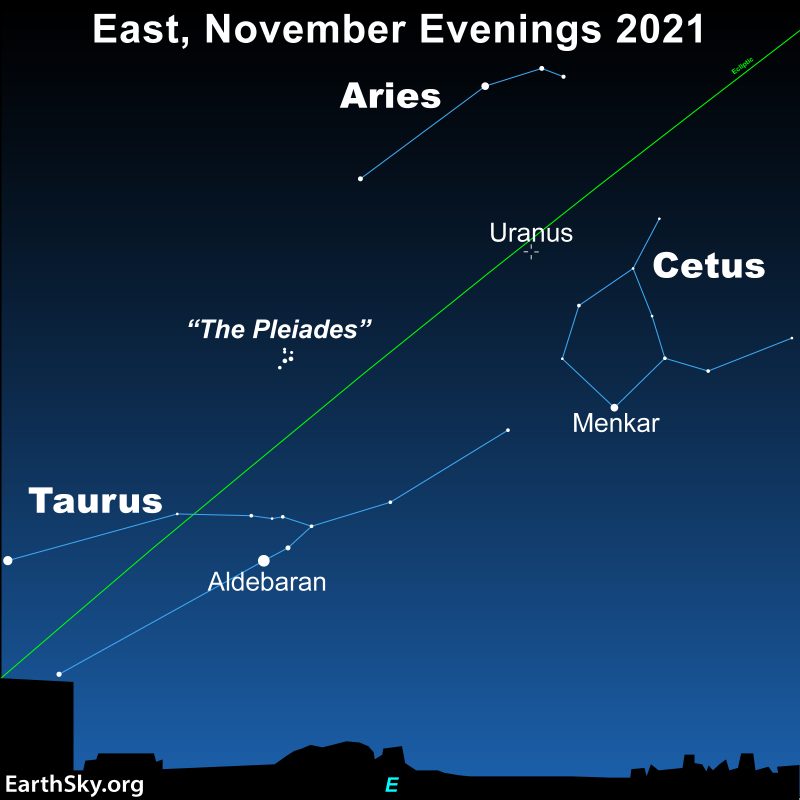
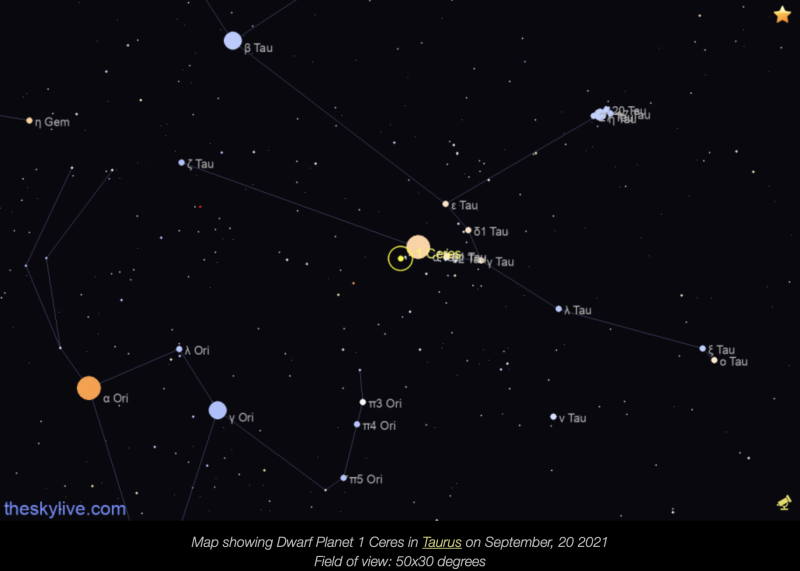
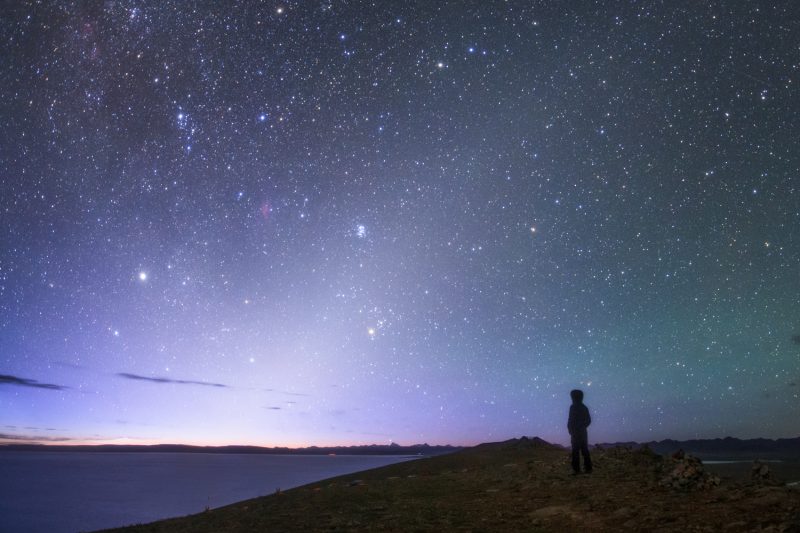
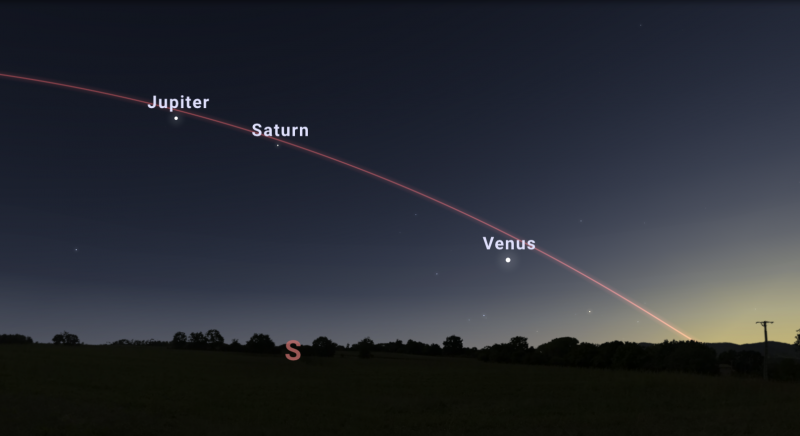
Stars near the moon in late November and early December
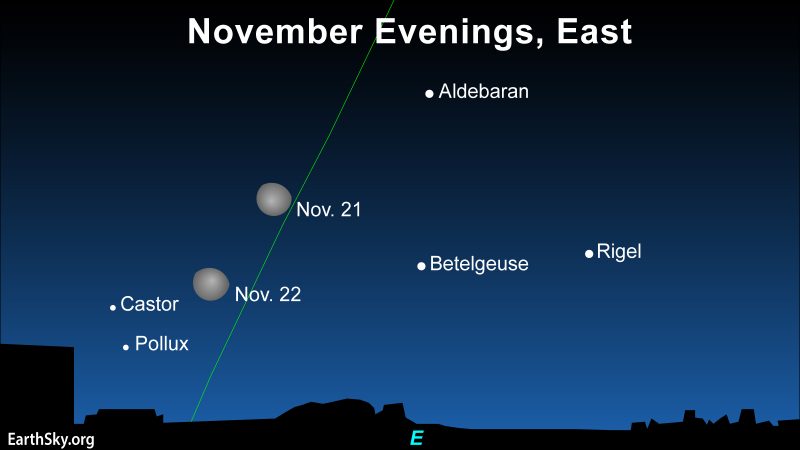
Planets in November 2021
Venus is fresh from its October 29 greatest elongation (its greatest distance from the sun on our sky’s dome for this evening apparition) when November begins. The brightest planet is easily seen from across Earth throughout November 2021.
For Southern Hemisphere skywatchers, this is an excellent to time to view Venus. Try the evening of November 6, when the moon will be a very slim crescent just above the sunset point. By the evening of November 7, the moon will be a fatter crescent, setting longer after the sun, very near Venus. On the next evening, November 8, the star-forming nebula M8 might be in reach with optical aid. It’ll be glowing subtly just beyond the moon’s dark side. Binoculars will enhance the scene.
For Northern Hemisphere skywatchers, the planet will appear lower in the sky, more to one side (the left side) of the sunset. But Venus will still be a dazzling light in the sunset direction throughout November 2021. You’ll also see the moon slide past Venus on the evenings of November 7 and 8, 2021. Northern viewers might see the very thin waxing crescent moon on November 6 as well. For a special view, use binoculars to place the moon and Venus in the same field. You’ll also see earthshine, a mysterious glow on the moon’s night side.
For us on the northern half of Earth’s globe, the view of Venus will improve throughout November. That seems paradoxical since Venus has reached the end of its tether with respect to the sun; its distance from the sun is now decreasing. Yet the view improves because, as Earth moves around the sun, the evening angle of the ecliptic – or path of the sun, moon and planets in our sky – is shifting upward. The effect is to carry Venus higher in the west after sunset.
Jupiter is the second-brightest starlike object in the November evening sky (only Venus appears as a brighter “star”). Jupiter is still near Saturn in the sky, nearly a year after their late 2020 great conjunction. Watch for Jupiter and Saturn near the moon on November 9, 10 and 11, 2021.
We call Jupiter the king of the planets because it’s the largest planet in our solar system. It’s second only to Venus in brightness among the planets, and among the stars in the November sky. In November 2021, Jupiter is in front of the stars of eastern Capricornus. For people with very good eyesight and who are in a dark site away from city lights, look just below Jupiter for two dim stars, Deneb Algiedi (aka Delta Caprcorni) and Nashira (aka Gamma Capricorni). Binocular users will have no trouble seeing them. Throughout November, Jupiter moves eastward every night, leaving these two stars behind as December approaches.
Saturn is fainter than Jupiter, but brighter than most stars. It’s golden in color and shines with a steady light. Saturn can be overlooked. But it’s easy to identify. Simply fully extend your arm and make a fist. Place bright Jupiter on the left side, and Saturn will be the object on the right side.
As with Jupiter, Saturn can be seen in November 2021 moving in front of the background stars of Capricornus. Those people using only their eyes and who have very good eyesight, as well as binocular users, will see Saturn sliding below the dim star Upsilon Capricorni throughout November.
All month long, watch Venus, Saturn, and Jupiter. The two giant planets move toward brilliant Venus. By the end of November, Saturn will sit nearly midway between Jupiter and Venus, forming planetary bookends!
Mercury, the smallest planet and innermost to the sun, was visible earlier this month. But it’s not visible in late November.
Mars passed directly behind the sun on October 8, 2021. So it still appears too close to the sun to be seen. The red planet will return to the morning sky in late December to begin another long cycle of visibility. 2022 will be a pretty good year for Mars!
An almost-total eclipse of the moon November 18-19
An amazing partial lunar eclipse happened the overnight on November 18. At mid-eclipse, 97% of the moon was covered by Earth’s shadow. It took on the reddish hue of a totally eclipsed moon. Also, the nearby and delicate Pleiades star cluster was visible.
All in all, a heavenly eclipse for us in North America. See a selection of eclipse photos here.

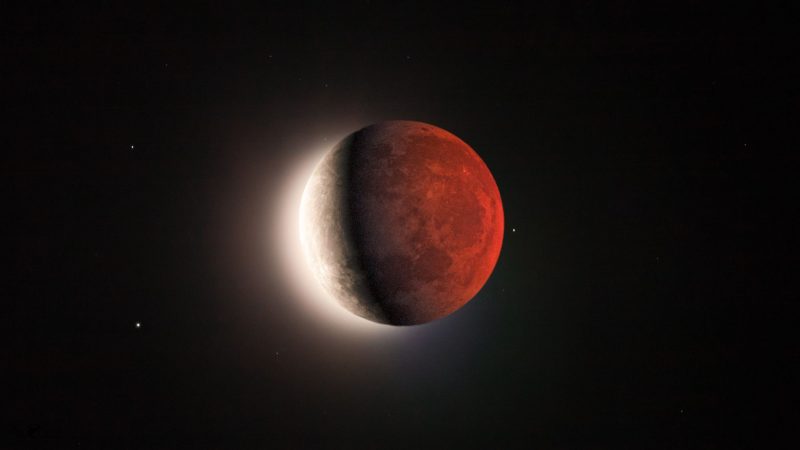
Meteor showers in November

The famous Leonid meteors start November 6 and run through the end of the month, peaking on November 17 before dawn. In 2021, the waxing gibbous moon hang around most of the night, brightening the sky and washing out many of the meteors. We got only one photo! You’ll see it above.
The Leonid meteor shower is known for periodic storms of historic proportions, when shooting stars fall like rain. No storm was predicted for the 2021 Leonids.
You might still catch some Leonid meteors through the end of November. They result from Earth plowing into the orbital path of Comet 55P/Tempel-Tuttle. Comets litter their orbits with bits of debris. These bits of dust smack into Earth’s atmosphere and vaporize, creating the light we know as meteors. You don’t need to know a shower’s radiant point to enjoy seeing a meteor streak across the sky. But, if you want to see it, the Leonids radiate from the contellation Leo the Lion.
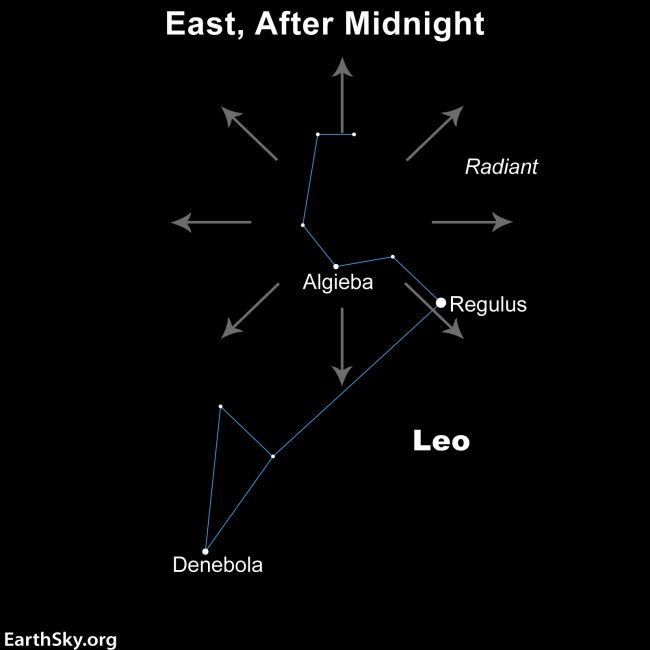
Some resources to enjoy
Visit EarthSky’s Best Places to Stargaze to find a dark-sky location near you.
Post your planet photos at EarthSky Community Photos.
Try Stellarium-Web or Try TheSkyLive for a precise view from your location
Try Stellarium for a precise view from your location.
The Old Farmer’s Almanac provides specific planet rise and set info (U.S. and Canada)
Timeanddate.com provides specific planet rise and set info (worldwide)
Click here for recommended almanacs to find out precise rise and set times
Translate Universal Time (UTC) to your time
Read: Ecliptic is the sun’s path in our sky
Planet-observing is easy: Top tips here
Also see the indispensable Observer’s Handbook, from the Royal Astronomical Society of Canada
Don’t miss anything. Subscribe to EarthSky News by email. It’s free!
Which ones are the visible planets?
In their outward order from the sun, the five bright planets are Mercury, Venus, Mars, Jupiter and Saturn. These are the planets easily visible without an optical aid. They’re the planets watched by our ancestors since time immemorial. These planets do appear bright in our sky. They are typically as bright as – or brighter than – the brightest stars. Plus, these relatively nearby worlds tend to shine with a steadier light than the distant, twinkling stars.
You can spot them, and come to know them as faithful friends, if you try.

Bottom line: All you need to know about how to find the bright planets of the solar system during the last half of November 2021.
Help EarthSky keep going! Donate now.
The post Visible planets – and more – in late November 2021 first appeared on EarthSky.
from EarthSky https://ift.tt/2SL2h7q
Find these visible planets in November 2021: Venus, Jupiter, Saturn, Mercury, Mars, Uranus
Try Stellarium for a precise view from your location.
Visible planets, the moon and more




Stars near the moon in late November and early December

Planets in November 2021
Venus is fresh from its October 29 greatest elongation (its greatest distance from the sun on our sky’s dome for this evening apparition) when November begins. The brightest planet is easily seen from across Earth throughout November 2021.
For Southern Hemisphere skywatchers, this is an excellent to time to view Venus. Try the evening of November 6, when the moon will be a very slim crescent just above the sunset point. By the evening of November 7, the moon will be a fatter crescent, setting longer after the sun, very near Venus. On the next evening, November 8, the star-forming nebula M8 might be in reach with optical aid. It’ll be glowing subtly just beyond the moon’s dark side. Binoculars will enhance the scene.
For Northern Hemisphere skywatchers, the planet will appear lower in the sky, more to one side (the left side) of the sunset. But Venus will still be a dazzling light in the sunset direction throughout November 2021. You’ll also see the moon slide past Venus on the evenings of November 7 and 8, 2021. Northern viewers might see the very thin waxing crescent moon on November 6 as well. For a special view, use binoculars to place the moon and Venus in the same field. You’ll also see earthshine, a mysterious glow on the moon’s night side.
For us on the northern half of Earth’s globe, the view of Venus will improve throughout November. That seems paradoxical since Venus has reached the end of its tether with respect to the sun; its distance from the sun is now decreasing. Yet the view improves because, as Earth moves around the sun, the evening angle of the ecliptic – or path of the sun, moon and planets in our sky – is shifting upward. The effect is to carry Venus higher in the west after sunset.
Jupiter is the second-brightest starlike object in the November evening sky (only Venus appears as a brighter “star”). Jupiter is still near Saturn in the sky, nearly a year after their late 2020 great conjunction. Watch for Jupiter and Saturn near the moon on November 9, 10 and 11, 2021.
We call Jupiter the king of the planets because it’s the largest planet in our solar system. It’s second only to Venus in brightness among the planets, and among the stars in the November sky. In November 2021, Jupiter is in front of the stars of eastern Capricornus. For people with very good eyesight and who are in a dark site away from city lights, look just below Jupiter for two dim stars, Deneb Algiedi (aka Delta Caprcorni) and Nashira (aka Gamma Capricorni). Binocular users will have no trouble seeing them. Throughout November, Jupiter moves eastward every night, leaving these two stars behind as December approaches.
Saturn is fainter than Jupiter, but brighter than most stars. It’s golden in color and shines with a steady light. Saturn can be overlooked. But it’s easy to identify. Simply fully extend your arm and make a fist. Place bright Jupiter on the left side, and Saturn will be the object on the right side.
As with Jupiter, Saturn can be seen in November 2021 moving in front of the background stars of Capricornus. Those people using only their eyes and who have very good eyesight, as well as binocular users, will see Saturn sliding below the dim star Upsilon Capricorni throughout November.
All month long, watch Venus, Saturn, and Jupiter. The two giant planets move toward brilliant Venus. By the end of November, Saturn will sit nearly midway between Jupiter and Venus, forming planetary bookends!
Mercury, the smallest planet and innermost to the sun, was visible earlier this month. But it’s not visible in late November.
Mars passed directly behind the sun on October 8, 2021. So it still appears too close to the sun to be seen. The red planet will return to the morning sky in late December to begin another long cycle of visibility. 2022 will be a pretty good year for Mars!
An almost-total eclipse of the moon November 18-19
An amazing partial lunar eclipse happened the overnight on November 18. At mid-eclipse, 97% of the moon was covered by Earth’s shadow. It took on the reddish hue of a totally eclipsed moon. Also, the nearby and delicate Pleiades star cluster was visible.
All in all, a heavenly eclipse for us in North America. See a selection of eclipse photos here.


Meteor showers in November

The famous Leonid meteors start November 6 and run through the end of the month, peaking on November 17 before dawn. In 2021, the waxing gibbous moon hang around most of the night, brightening the sky and washing out many of the meteors. We got only one photo! You’ll see it above.
The Leonid meteor shower is known for periodic storms of historic proportions, when shooting stars fall like rain. No storm was predicted for the 2021 Leonids.
You might still catch some Leonid meteors through the end of November. They result from Earth plowing into the orbital path of Comet 55P/Tempel-Tuttle. Comets litter their orbits with bits of debris. These bits of dust smack into Earth’s atmosphere and vaporize, creating the light we know as meteors. You don’t need to know a shower’s radiant point to enjoy seeing a meteor streak across the sky. But, if you want to see it, the Leonids radiate from the contellation Leo the Lion.

Some resources to enjoy
Visit EarthSky’s Best Places to Stargaze to find a dark-sky location near you.
Post your planet photos at EarthSky Community Photos.
Try Stellarium-Web or Try TheSkyLive for a precise view from your location
Try Stellarium for a precise view from your location.
The Old Farmer’s Almanac provides specific planet rise and set info (U.S. and Canada)
Timeanddate.com provides specific planet rise and set info (worldwide)
Click here for recommended almanacs to find out precise rise and set times
Translate Universal Time (UTC) to your time
Read: Ecliptic is the sun’s path in our sky
Planet-observing is easy: Top tips here
Also see the indispensable Observer’s Handbook, from the Royal Astronomical Society of Canada
Don’t miss anything. Subscribe to EarthSky News by email. It’s free!
Which ones are the visible planets?
In their outward order from the sun, the five bright planets are Mercury, Venus, Mars, Jupiter and Saturn. These are the planets easily visible without an optical aid. They’re the planets watched by our ancestors since time immemorial. These planets do appear bright in our sky. They are typically as bright as – or brighter than – the brightest stars. Plus, these relatively nearby worlds tend to shine with a steadier light than the distant, twinkling stars.
You can spot them, and come to know them as faithful friends, if you try.

Bottom line: All you need to know about how to find the bright planets of the solar system during the last half of November 2021.
Help EarthSky keep going! Donate now.
The post Visible planets – and more – in late November 2021 first appeared on EarthSky.
from EarthSky https://ift.tt/2SL2h7q

Aucun commentaire:
Enregistrer un commentaire